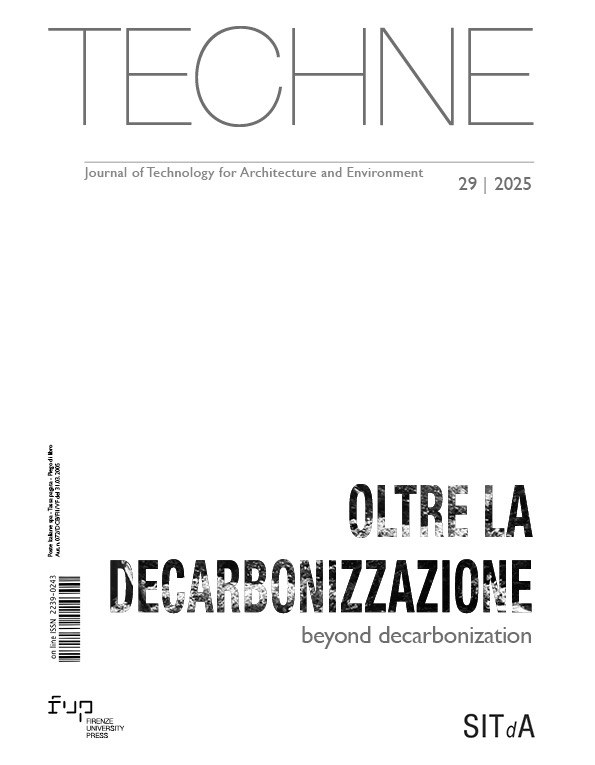Published 2025-07-31
Keywords
- Tree hubs,
- Circular green management,
- Circular cities
How to Cite
Copyright (c) 2025 Chiara Pradel

This work is licensed under a Creative Commons Attribution 4.0 International License.
Abstract
In line with the ambition to combat climate change and reduce greenhouse gas emissions by at least 55% by 2030, the EU has recently committed to planting 3 billion trees (see the EU Forest Strategy, 2021). On a global level, a number of cities have implemented reforestation programmes and urban greening initiatives. Within the framework of this vast and urgent commitment, the paper examines the emerging phenomenon of Tree Hubs, where unwanted trees and plants can be placed after harvesting and before replanting, with a particular focus on The Netherlands.
Downloads
References
- Backes, C. W. and Van der Veen, G. A., (2020), “Urgenda: The Final Judgment of the Dutch Supreme Court”, Journal for European Environmental and Planning Law, Vol. 17, pp. 307-21. Available at: https://doi.org/10.1163/18760104-01703004 (Accessed on 18/08/2024). DOI: https://doi.org/10.1163/18760104-01703004
- Boztas, S., (2021), “Every tree counts: Dutch come up with cunning way to create forests for free”, The Guardian, 26 Nov 2021. Available at: https://www.theguardian.com/environment/2021/nov/26/every-tree-counts-amsterdam-forest-leads-way-with-sapling-donation-plan?CMP=share_btn_url (Accessed on 03/07/2024).
- Buijs, A. E., Mattijssen, T. J., Van der Jagt, A. P. N., Ambrose-Oji, B., Andersson, E., Elands, B. H., et al. (2016). “Active citizenship for urban green infrastructure: Fostering the diversity and dynamics of citizen contributions through mosaic governance”, Current Opinion in Environmental Sustainability, Vol. 22, pp. 1–6. Available at: https://doi.org/10.1016/j.cosust.2017.01.002 (Accessed on 07/07/2024). DOI: https://doi.org/10.1016/j.cosust.2017.01.002
- Buitelaar, E., Grommen, E. and Van Der Krabben, E. (2017), “The self-organizing city: An analysis of the institutionalization of organic urban development in the Netherlands”, in Squires, G., Heurkens, E., Peiser, R. (Eds.), Routledge Companion to Real Estate Development, Routledge, London, pp. 169-82.
- Bright, R. M., Zhao, K., Jackson, R. B. & Cherubini, F. (2015), “Quantifying surface albedo and other direct biogeophysical climate forcings of forestry activities”, Glob. Change Biol., Vol. 21, pp. 3246–66. Available at: https://doi.org/10.1111/gcb.12951 (Accessed on 28/11/2024) DOI: https://doi.org/10.1111/gcb.12951
- Dobbs, C., Martinez-Harms, M.J. and Kendal, D., (2017), “Ecosystem services”. In: Ferrini, F., Konijnendijk van den Bosch, C. and Fini, A. (Eds), Routledge handbook of urban forestry, Routledge, London, pp. 51–64.
- Dorst, H., van der Jagt, A., Raven, R., Runhaar, H., (2019), “Urban greening through nature-based solutions – Key characteristics of an emerging concept”, Sustainable Cities and Society, Vol. 49, pp.1-8. Available at: https://doi.org/10.1016/j.scs.2019.101620 (Accessed on 07/07/2024). DOI: https://doi.org/10.1016/j.scs.2019.101620
- European Commission, (2020), A new Circular Economy Action Plan, Brussels. Available at: https://eur-lex.europa.eu/resource.html?uri=cellar:9903b325-6388-11ea-b735-01aa75ed71a1.0017.02/DOC_1&format=PDF (Accessed on 07/07/2024).
- European Commission, (2021), New EU Forest Strategy for 2030, Brussels. Available at: https://eur-lex.europa.eu/legal-content/it/TXT/?uri=CELEX%3A52021DC0572 (Accessed on 08/07/2024).
- Griscom, B. W., et al. (2017), “Natural climate solutions”, Proceedings of the National Academy of Sciences, Vol. 114, pp. 11645-50. Available at: https://doi.org/10.1073/pnas.1710465114 (Accessed on 07/07/2024). DOI: https://doi.org/10.1073/pnas.1710465114
- International Union for the Conservation of Nature, (2020), IUCN Global Standard for Nature-based Solutions. A user-friendly framework for the verification, design and scaling up of NbS. International Union for the Conservation of Nature, Gland. Available at: https://doi.org/10.2305/IUCN.CH.2020.08.en (Accessed on 28/11/2024). DOI: https://doi.org/10.2305/IUCN.CH.2020.08.en
- Konijnendijk, C.C., (2022), “Evidence‐based guidelines for greener, healthier, more resilient neighbourhoods: Introducing the 3–30–300 rule”, Journal of Forestry Research, Vol. 34, pp. 821-30. Available at: https://doi.org/10.1007/s11676-022-01523-z (Accessed on 20/08/2024). DOI: https://doi.org/10.1007/s11676-022-01523-z
- Lemenih, M., & Kassa, H., (2014), “Re-Greening Ethiopia: History, Challenges and Lessons”, Forests, Vol. 8, pp. 1896-1909. Available at: https://doi.org/10.3390/f5081896 (Accessed on 20/08/2024). DOI: https://doi.org/10.3390/f5081896
- Mens, J., van Bueren, E., Vrijhoef, R. and Heurkens, E., (2021), “A typology of social entrepreneurs in bottom-up urban development”, Cities, Vol. 110. Available at: https://doi.org/10.1016/j.cities.2020.103066 (Accessed on 19/08/2024). DOI: https://doi.org/10.1016/j.cities.2020.103066
- Milthorpe, N. (2019), The Poetics and Politics of Gardening in Hard Times, Lexington Books, London. DOI: https://doi.org/10.5040/9781978735842
- Mussinelli E., Tartaglia A., Bisogni L., Malcevschi S. (2018), “The role of Nature-Based Solutions in architectural and urban design”, Techne, Vol. 15, pp.116-23. Available at: https://doi.org/10.13128/Techne-22112 (Accessed on 28/11/2024).
- Riedman, E., Roman, L., Pearsall, H., Maslin, M., Ifill, T., Dentice, D. (2022), “Why don’t people plant trees? Uncovering barriers to participation in urban tree planting initiatives”, Urban Forestry & Urban Greening, Vol. 73. Available at: https://doi.org/10.1016/j.ufug.2022.127597 (Accessed on 28/11/2024). DOI: https://doi.org/10.1016/j.ufug.2022.127597
- Spirn, A.W. (1984), The Granite Garden. Urban Nature and Human Design, Basic Books, New York.
- Waring, B., Neumann, M., Prentice, I.C., Adams, M., Smith, P., and Siegert, M., (2020), “Forests and Decarbonization – Roles of Natural and Planted Forests”, Frontiers in Forests and Global Change, Vol 3. Available at: https://doi.org/10.3389/ffgc.2020.00058 (Accessed on 20/08/2024). DOI: https://doi.org/10.3389/ffgc.2020.00058
- Warner, E., et al. (2023) “Young mixed planted forests store more carbon than monocultures – a meta-analysis”, Frontiers in Forests and Global Change, Vol 6. Available at: https://doi.org/10.3389/ffgc.2023.1226514 (Accessed on 20/08/2024). DOI: https://doi.org/10.3389/ffgc.2023.1226514





